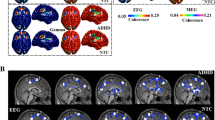Abstract
The directed transfer function (DTF) is a measure based on the concept of Granger’s causality, which associated with a neurofeedback system, can represent an important analysis tool to support the treatment of neuropsychiatric disorders. Defined in the structure of the multivariate autoregressive model (MVAR), the DTF provides a spectral estimate of the strength and direction of any causal link between the signals acquired by electroencephalography (EEG). This study aims to estimate the directed functional connectivity related to the attention status of healthy adult individuals during neurofeedback sessions, aiming to better understand how the neuronal regions communicate and influence each other’s activity and study the feasibility of using these algorithms with neurofeedback. Data were collected from 19 individuals, eleven male and eight female, with an average age of 21.21 years, standard deviation of 2.39 and an age range of 18–26 years. As a result, they were able to identify changes in the direction and strength of the interaction flow between certain brain regions that occurred during the sessions, suggesting that the sessions enabled individuals to activate brain regions related to the state of attention. The main contribution presented in the study was the use of the mathematical methods mentioned to identify and analyze brain modulations in individuals who participated in neurofeedback sessions related to the strengthening of the state of attention.
Access this chapter
Tax calculation will be finalised at checkout
Purchases are for personal use only
Similar content being viewed by others
References
Kaur C, Singh P, Sahni S (2019) Towards efficacy of EEG neurofeedback from traditional to advanced approach: a review. Biomed Pharmacol J 12:619–627
Sherlin LH, Arns M, Lubar J et al (2011) Neurofeedback and basic learning theory: implications for research and practice. J Neurother 15:292–304
Larsen S, Sherlin L (2013) Neurofeedback: an emerging technology for treating central nervous system dysregulation. Psychiatr Clin 36:163–168
Young KD, Zotev V, Phillips R et al (2014) Real-time FMRI neurofeedback training of amygdala activity in patients with major depressive disorder. PLoS ONE 9(2):e88785
Nakamura-Palacios EM, de Almeida Benevides MC, Penha Zago-Gomes M et al (2012) Auditory event-related potentials (P3) and cognitive changes induced by frontal direct current stimulation in alcoholics according to Lesch alcoholism typology. Int J Neuropsychopharmacol 15:601–616
Nakamura-Palacios EM, Lopes IBC, Souza RA et al (2016) Ventral medial prefrontal cortex (vmPFC) as a target of the dorsolateral prefrontal modulation by transcranial direct current stimulation (tDCS) in drug addiction. J Neural Transm 123:1179–1194
Dai Z, De Souza J, Lim J et al (2017) EEG cortical connectivity analysis of working memory reveals topological reorganization in theta and alpha bands. Front Hum Neurosci 11:237
Wang H, Wu X, Wen X, Lei X, Gao Y, Yao L (2019) Exploring directed functional connectivity based on electroencephalography source signals using a global cortex factor-based multivariate autoregressive model. J Neurosci Methods 318:6–16
Friston KJ (2011) Functional and effective connectivity: a review. Brain Connect 1:13–36
Wen X, Rangarajan G, Ding M (2013) Multivariate Granger causality: an estimation framework based on factorization of the spectral density matrix. Philos Trans R Soc A Math Phys Eng Sci 371:20110610
Baccalá LA, Sameshima K (2001) Partial directed coherence: a new concept in neural structure determination. Biol Cybernet 84:463–474
Dutta S, Singh M, Kumar A (2018) Automated classification of non-motor mental task in electroencephalogram based brain-computer interface using multivariate autoregressive model in the intrinsic mode function domain. Biomed Sig Process Control 43:174–182
Kamiński M, Ding M, Truccolo WA, Bressler SL (2001) Evaluating causal relations in neural systems: granger causality, directed transfer function and statistical assessment of significance. Biol Cybernet 85:145–157
Astolfi L, Cincotti F, Mattia D et al (2008) Tracking the time-varying cortical connectivity patterns by adaptive multivariate estimators. IEEE Trans Biomed Eng 55:902–913
Hata M, Kazui H, Tanaka T et al (2016) Functional connectivity assessed by resting state EEG correlates with cognitive decline of Alzheimer’s disease—an eLORETA study. Clin Neurophys 127:1269–1278
Umesh DS, Tikka SK, Goyal N, Nizamie SH, Sinha VK (2016) Resting state theta band source distribution and functional connectivity in remitted schizophrenia. Neurosci Lett 630:199–202
Storti SF, Boscolo Galazzo I, Montemezzi S, Menegaz G, Pizzini FB (2017) Dual-echo ASL contributes to decrypting the link between functional connectivity and cerebral blow flow. Hum Brain Mapp 38:5831–5844
Lehmann D, Faber PL, Gianotti LRR, Kochi K, Pascual-Marqui RD (2006) Coherence and phase locking in the scalp EEG and between LORETA model sources, and microstates as putative mechanisms of brain temporo-spatial functional organization. J Phys Paris 99:29–36
Cannon R, Congedo M, Lubar J, Hutchens T (2009) Differentiating a network of executive attention: LORETA neurofeedback in anterior cingulate and dorsolateral prefrontal cortices. Int J Neurosci 119:404–441
Lancaster JL, Woldorff MG, Parsons LM et al (2000) Automated Talairach atlas labels for functional brain mapping. Hum Brain Mapp 10:120–131
Kus R, Kaminski M, Blinowska KJ (2004) Determination of EEG activity propagation: pair-wise versus multichannel estimate. IEEE Trans Biomed Eng 51:1501–1510
Ligeza TS, Wyczesany M, Tymorek AD, Kamiński M (2016) Interactions between the prefrontal cortex and attentional systems during volitional affective regulation: an effective connectivity reappraisal study. Brain Topogr 29:253–261
He B, Astolfi L, Valdés-Sosa PA et al (2019) Electrophysiological brain connectivity: theory and implementation. IEEE Trans Biomed Eng 66:2115–2137
Acknowledgements
The authors are grateful for the financial support of the Brazilian agencies FAPES, CAPES and CNPq (process no 80615503, 304049/2019-0, 307531/2018-0) (FAPES/CNPq No. 05/2017—PRONEM, TO: 84/2017).
Author information
Authors and Affiliations
Corresponding author
Editor information
Editors and Affiliations
Ethics declarations
The authors declare that they have no conflict of interest.
Rights and permissions
Copyright information
© 2022 Springer Nature Switzerland AG
About this paper
Cite this paper
Casagrande, W.D., Nakamura-Palacios, E.M., Frizera-Neto, A. (2022). Estimation of Directed Functional Connectivity in Neurofeedback Training Focusing on the State of Attention. In: Bastos-Filho, T.F., de Oliveira Caldeira, E.M., Frizera-Neto, A. (eds) XXVII Brazilian Congress on Biomedical Engineering. CBEB 2020. IFMBE Proceedings, vol 83. Springer, Cham. https://doi.org/10.1007/978-3-030-70601-2_250
Download citation
DOI: https://doi.org/10.1007/978-3-030-70601-2_250
Published:
Publisher Name: Springer, Cham
Print ISBN: 978-3-030-70600-5
Online ISBN: 978-3-030-70601-2
eBook Packages: EngineeringEngineering (R0)




